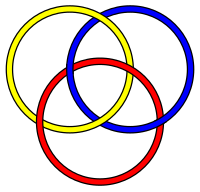முடிச்சுக் கணிதம்


கணிதவியலில் முடிச்சுக் கணிதம் அல்லது முடிச்சுக் கருத்தியம் அல்லது முடிச்சியல் என்பது ஒரு இடவியல் துறையின் ஒரு பகுதியாகும். அன்றாடம் கயிறுகளில் இடும் முடிச்சுகளால் உந்தப்பட்டு எழுந்தாலும், கணிதவியல் முடிச்சு என்பது சற்று வேறானது. கணித முடிச்சியலில் நுனிகள் இரண்டும் இணைந்தே இருக்கும். எனவே முடிச்சு என்பது கணிதவியலில் கயிறால் செய்த, மூன்று செங்குத்தான திசைகளில் நெளியக்கூடிய, (சிக்குண்ட) வளையம் அல்லது "வட்டம்" போன்றது. கணிதவியலில் முடிச்சு என்பதை உள்பதிவமைப்பு (உள்பதிந்த கணித அமைப்பு (embedding or imbedding)) கொண்ட முத்திரட்சி யூக்ளீடிய வெளி (முப்பரிமாண வெளி) R3 "வட்டம்" என்பர். இருதிசை வெளியில் (2-dimensional) அமைந்த கணித முடிச்சு ஒன்றை வேறொன்றாக முத்திசை வெளி வழி அதனையே மாற்றி அமைக்க முடியும் எனில் அவை ஈடானவை (சமமானவை). இதனை சூழல் ஓருரு (ambient isotopy, ஆம்பியன்ட் ஐசோடோப்பி) என்பர்.
முடிச்சியல் தோற்றியவர்களின் முன்னிருந்த நோக்கம், முடிச்சுகளின் பல்வேறு வகைகளைப் பற்றி விரிவான அட்டவணை உருவாக்கலாம் என இருந்தது. 19 ஆவது நூற்றாண்டில் துவங்கி தற்பொழுது ஆறு பில்லியன்களுக்கும் மேலான முடிச்சுகள் அட்டவணைப் படுத்தப் பட்டுள்ளன.
வரலாறு[தொகு]
முடிச்சுகளைப் பற்றி வரலாற்றுக் காலத்துக்கு முந்தைய காலங்களிலேயே பதிவுகள் இருப்பதைத் தொல்லியல் ஆய்வாளர்கள் கண்டுபிடித்து இருக்கிறார்கள். பல்வேறு குறிப்புகளை நினைவில் கொள்ளவும், அழகுக்காகவும், மெய்யியல் மதம் சார்ந்த பயன்பாடுகளுக்காகவும் முடிச்சுகளைப் பயன்படுத்தியுள்ளனர். சீனாவில் கலை வேலைப்பாடுகளில் முடிச்சுகள் கி.மு பல நூற்றாண்டுகள் காலப்பகுதியில் காணப்படுகின்றன. நுனி இல்லாத முடிச்சுகள் திபெத்திய புத்தமதத்தில் கானப்படுகின்றன. போரோமியன் வளையங்கள் (Borromean rings) பல பண்பாடுகளில் காணப்படுகின்றன. இவை ஒற்றுமையை வலியுறுத்தும் கருத்தாகப் பயன்படுத்தப்பட்டுள்ளன. கெல்டிக் மக்கள் பல்வேறு முடிச்சுகள் பற்றி நூல்களில் காட்டியுள்ளனர்.

கணித முடிச்சியல் பற்றிய கருத்துகளின் துவக்கம், 19 ஆவது நூற்றாண்டில் கார்ல் பிரெடரிக் கவுசு அவர்களின் தொடுப்பு தொகைக்கணிதக் கருத்துகள்(linking integral) , 1860களில் லார்டு கெல்வினின் அணுக்கள் முடிச்சுகள் என்னும் கருத்து, பீட்டர் குத்ரீ டேய்ட் (Peter Guthrie Tait) அவர்களின் முடிச்சுகள் அட்டவணை போன்றவற்றில் அடங்கும். ஆனால் கணித முடிச்சியல் என்பது இடவியலின் ஒரு பகுதி என 20 ஆம் நூற்றாண்டின் துவக்கத்திலேதான் உணரப்பட்டது. மாசு டேன் (Max Dehn), சே. டபிள்யூ. அலெக்சாண்டர் (J. W. Alexander) முதலானோர்களின் ஆய்வுகள் முன்னோடியாக அமைந்தன.
20 ஆம் நூற்றாண்டின் கடைசி சில பத்தாண்டுகளில் டிஎன்ஏ மடிப்புகள் முதலானவற்றில் முடிச்சு பற்றிய அறிவு பயன்படுவதை உணர்ந்து இத்துறையை மேலும் வளர்த்தெடுத்தனர்.
உசாத்துணை நூல்கள்[தொகு]
- Adams, Colin (2004), The Knot Book: An Elementary Introduction to the Mathematical Theory of Knots, American Mathematical Society, ISBN 0821836781
- Adams, Colin; Hildebrand, Martin; Weeks, Jeffrey (1991), "Hyperbolic invariants of knots and links", Transactions of the American Mathemathical Society, 326 (1): 1–56
- Bar-Natan, Dror (1995), "On the Vassiliev knot invariants", Topology, 34 (2): 423–472
{{citation}}: CS1 maint: date and year (link) - Collins, Graham (2006), "Computing with Quantum Knots", Scientific American
{{citation}}: Unknown parameter|month=ignored (|date=suggested) (help) - Conway, John (1970), "An enumeration of knots and links, and some of their algebraic properties", Computational Problems in Abstract Algebra (Proc. Conf., Oxford, 1967), Pergamon, pp. 329–358
{{citation}}: Unknown parameter|middle=ignored (help) - Doll, Helmut; Hoste, Jim (1991), "A tabulation of oriented links. With microfiche supplement.", Math. Comp., 57 (196): 747–761
- Flapan, Erica (2000), "When topology meets chemistry: A topological look at molecular chirality", Outlooks, Cambridge University Press, Cambridge; Mathematical Association of America, Washington, DC, ISBN 0-521-66254-0
{{citation}}: CS1 maint: date and year (link) - Haefliger, André (1962), "Knotted (4k − 1)-spheres in 6k-space", Annals of Mathematics (2), 75: 452–466
- Hass, Joel (1998), "Algorithms for recognizing knots and 3-mainifolds", Chaos, Solitons and Fractals, Elsevier, 9: 569–581arXiv:math.GT/9712269
- Hoste, Jim; Thistlethwaite, Morwen; Weeks, Jeffrey (1998), "The first 1,701,935 knots", Math. Intelligencer, Springer, 20: 33–48
- Hoste, Jim (2005), "The enumeration and classification of knots and links", Handbook of Knot Theory (PDF), Amsterdam: Elsevier
- Levine, Jerome (1965), "A classification of differentiable knots", Annals of Mathematics (2), 1982: 15–50
- Kontsevich, Maxim (1993), "Vassiliev's knot invariants", I. M. Gelfand Seminar, Adv. Soviet Math., Providence, RI: Amer. Math. Soc., 16: 137–150
{{citation}}: Unknown parameter|part=ignored (help)CS1 maint: date and year (link) - Lickorish, W. B. Raymond (1997), An Introduction to Knot Theory, Graduate Texts in Mathematics, Springer-Verlag, ISBN 0-387-98254-X
- Perko, Kenneth (1974), "On the classification of knots", Proceedings of the American Mathematical Society, 45: 262–266
- Rolfsen, Dale (1976), Knots and Links, Publish or Perish, ISBN 0-914098-16-0
- Schubert, Horst (1949), "Die eindeutige Zerlegbarkeit eines Knotens in Primknoten", Heidelberger Akad. Wiss. Math.-Nat. Kl. (3): 57–104
{{citation}}: CS1 maint: date and year (link) - Silver, Dan (2006), "Knot theory's odd origins" (PDF), American Scientist, vol. 94, no. 2, pp. 158–165
- Simon, Jonathan (1986), "Topological chirality of certain molecules", Topology, 25: 229–235
- Sossinsky, Alexei (2002), Knots, mathematics with a twist, Harvard University Press, ISBN 0-674-00944-4
{{citation}}: CS1 maint: date and year (link) - Turaev, V. G. (1994), "Quantum invariants of knots and 3-manifolds", De Gruyter Studies in Mathematics, Berlin: Walter de Gruyter & Co., 18, ISBN 3-11-013704-6
{{citation}}: CS1 maint: date and year (link) - Witten, Edward (1989), "Quantum field theory and the Jones polynomial", Comm. Math. Phys., 121 (3): 351–399
{{citation}}: CS1 maint: date and year (link) - Zeeman, E. C. (1963), "Unknotting combinatorial balls", Annals of Mathematics (2), 78: 501–526
மேலும் படிக்க[தொகு]
அறிமுக பாட நூல்கள்[தொகு]
முடிச்சியல் (முடீச்சு கருத்தியம்) பற்றிய அறிமுக நூலகள் பல ஆங்கிலத்தில் உள்ளன. 1976 இல் வெளிவந்த ரால்ஃவ்சென் (Rolfsen) எழுதிய மேற்பட்டப்படிப்பு அல்லது மேலாண்டுகளில் பட்டப்படிப்பு மாணவர்களுக்கான நூல் புகழ்பெற்றது. லிக்கொரிழ்ச் (Lickorish) (1997), ஆடம்சு ( Adams) (2001) ஆகியவற்றையும் குறிப்பிடலாம்.
- Richard H. Crowell and Ralph Fox,Introduction to Knot Theory, 1977, ISBN 0-387-90272-4
- Gerhard Burde and Heiner Zieschang, Knots, De Gruyter Studies in Mathematics, 1985, Walter de Gruyter, ISBN 3-11-008675-1
- Louis H. Kauffman, On Knots, 1987, ISBN 0-691-08435-1
பரந்ததொகுப்பு[தொகு]
- William W. Menasco and Morwen Thistlethwaite (editors), Handbook of Knot Theory, Amsterdam : Elsevier, 2005. ISBN 0-444-51452-X
- Menasco and Thistlethwaite's handbook surveys a mix of topics relevant to current research trends in an manner accessible to advanced undergraduates but of interest to professional researchers.
வெளி இணைப்புகள்[தொகு]
வரலாறு[தொகு]
- Thomson, Sir William (Lord Kelvin), On Vertex Atoms, Proceedings of the Royal Society of Edinburgh, Vol. VI, 1867, pp. 94–105.
- Silliman, Robert H., William Thomson: Smoke Rings and Nineteenth-Century Atomism, Isis, Vol. 54, No. 4. (Dec., 1963), pp. 461–474. JSTOR link
- Movie of a modern recreation of Tait's smoke ring experiment
முடிச்சு அட்டவனைகளும் மென்பொருட்களும்[தொகு]
- KnotInfo: Table of Knot Invariants and Knot Theory Resources பரணிடப்பட்டது 2019-12-09 at the வந்தவழி இயந்திரம்
- The wiki Knot Atlas – detailed info on individual knots in knot tables
- KnotPlot – software to investigate geometric properties of knots
